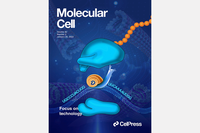NARILIS epitranscriptomic work makes the cover of the Molecular Cell journal
The research group of Dr. Damien Hermand (UNamur, NARILIS, URPhyM) studies the molecular mechanisms involved in the control of gene expression, the process by which genes are transcribed into mRNA and subsequently translated into proteins. Their research aims at understanding how a single genome can encode the blueprint of a complex organism with highly differentiated cell-and tissue-types. Their attention focuses on posttranscriptional mRNA modifications, referred to as epitranscriptomic modifications. Damien Hermand’s team developed Rho-seq, a new method to map the transcriptome-wide distribution of dihydrouridine RNA modifications. Their latest results have recently been published in the journal “Molecular Cell” (Finet et al., 2021). Moreover, their epitranscriptomic study is featured on the front cover of the journal! The picture illustrates that the dihydrouridine RNA modification (the snail) is present on eukaryotic mRNAs. Dihydrouridylated codons are translated more slowly by the ribosome (blue shapes) and modification of the tubulin-encoding mRNA is required for proper meiotic chromosome segregation (microtubules are depicted in the background). The snail is the emblematic animal in Namur, Belgium, where this study was conducted.
The team: Damien Hermand (PI), Olivier Finet (former PhD student), Carlo Yague-Sanz (FNRS Postdoctoral Researcher) and Valérie Migeot (lab technician).
Study conducted in collaboration with ULB (Denis Lafontaine), MIT, USA (Peter Dedon), Institut Curie, Paris (Antonin Morillon) and Université Paris-Saclay (Mathieu Rougemaille).
Contact: damien.hermand@unamur.be
Finet O, Yague-Sanz C, Krüger LK, Tran P, Migeot V, Louski M, Nevers A, Rougemaille M, Sun J, Ernst FGM, Wacheul L, Wery M, Morillon A, Dedon P, Lafontaine DLJ, Hermand D. Transcription-wide mapping of dihydrouridine reveals that mRNA dihydrouridylation is required for meiotic chromosome segregation. Mol Cell. 2022 Jan 20;82(2):404-419.e9.
 NAmur Research Institute for LIfe Sciences
NAmur Research Institute for LIfe Sciences


